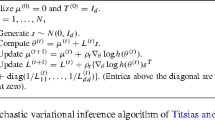Abstract
The paper obtains two principal results. First, using a new definition ofhigher-order (>2) matrix derivatives, the paper derives a recursion forcomputing any Gaussian multivariate moment. Second, the paper uses this resultin a perturbation method to derive equations for computing the 4th-orderTaylor-series approximation of the objective function of the linear-quadraticexponential Gaussian (LQEG) optimal control problem. Previously, Karp (1985)formulated the 4th multivariate Gaussian moment in terms of MacRae'sdefinition of a matrix derivative. His approach extends with difficulty to anyhigher (>4) multivariate Gaussian moment. The present recursionstraightforwardly computes any multivariate Gaussian moment. Karp used hisformulation of the Gaussian 4th moment to compute a 2nd-order approximationof the finite-horizon LQEG objective function. Using the simpler formulation,the present paper applies the perturbation method to derive equations forcomputing a 4th-order approximation of the infinite-horizon LQEG objectivefunction. By illustrating a convenient definition of matrix derivatives in thenumerical solution of the LQEG problem with the perturbation method, the papercontributes to the computational economist's toolbox for solving stochasticnonlinear dynamic optimization problems.
Similar content being viewed by others
References
Anderson, E.W. and Hansen, L.P. (1996). Perturbation methods for risk-sensitive economies. Working Paper, Department of Economics, University of Chicago, Chicago, IL.
Chen, B. and Zadrozny, P.A. (2000a). Estimated U.S. manufacturing capital and productivity based on an estimated dynamic economic model. Working paper, Department of Economics, Rutgers University, Camden, NJ.
Chen, B. and Zadrozny, P.A. (2000b). Perturbation solution of nonlinear rational expectations models. Working paper, presented at the Computational Economics segment of the SITE 2000 summer workshop, Department of Economics, Stanford University, Stanford, CA.
Collard, F. and Juillard, M. (2001). Accuracy of stochastic perturbation methods: the case of asset pricing models. Journal of Economic Dynamcis and Control, 25, 979-999.
Fleming, W.H. (1971). Stochastic control for small noise intensities. SIAM Journal of Control, 9, 473-517.
Fleming, W.H. and Souganidis, P.E. (1986). Asymptotic series and the method of vanishing viscosity. Indiana University Mathematics Journal, 35, 425-447.
Jacobson, D.H. (1973). Optimal stochastic linear systems with exponential performance criteria and their relation to deterministic differential games. IEEE Transactions on Automatic Control, AC-18, 124-131.
Judd, K.L. (1998). Numerical Methods in Economics. MIT Press, Cambridge, MA.
Karp, L.S. (1985). Higher moments in the linear-quadratic-Gaussian problem. Journal of Economic Dynamics and Control, 9, 41-54.
Laub, A.J. (1979). A Schur method for solving algebraic Riccati equations. IEEE Transactions on Automatic Control, 24, 913-921.
MacRae, E.C. (1974). Matrix derivatives with an application to an adaptive linear decision problem. Annals of Statistics, 2, 337-346.
Magnus, J.R. and Neudecker, H. (1988). Matrix Differential Calculus with Applications in Statistics and Econometrics. J. Wiley & Sons, New York, NY.
Sims, C.A. (2000). Second order solution of discrete time dynamic equilibrium models. Working paper, Department of Economics, Princeton University, Princeton, NJ.
Author information
Authors and Affiliations
Rights and permissions
About this article
Cite this article
Chen, B., Zadrozny, P.A. Higher-Moments in Perturbation Solution of the Linear-Quadratic Exponential Gaussian Optimal Control Problem. Computational Economics 21, 45–64 (2003). https://doi.org/10.1023/A:1022270430175
Issue Date:
DOI: https://doi.org/10.1023/A:1022270430175



